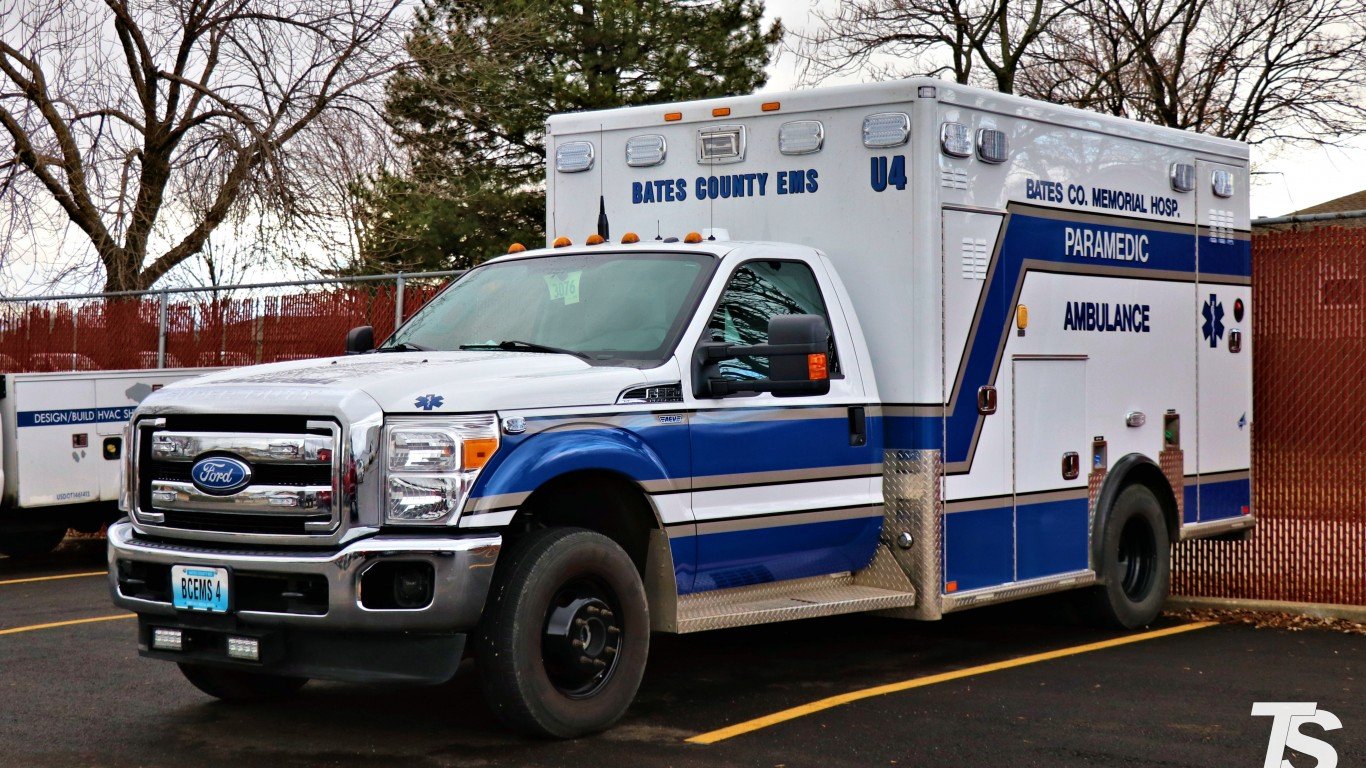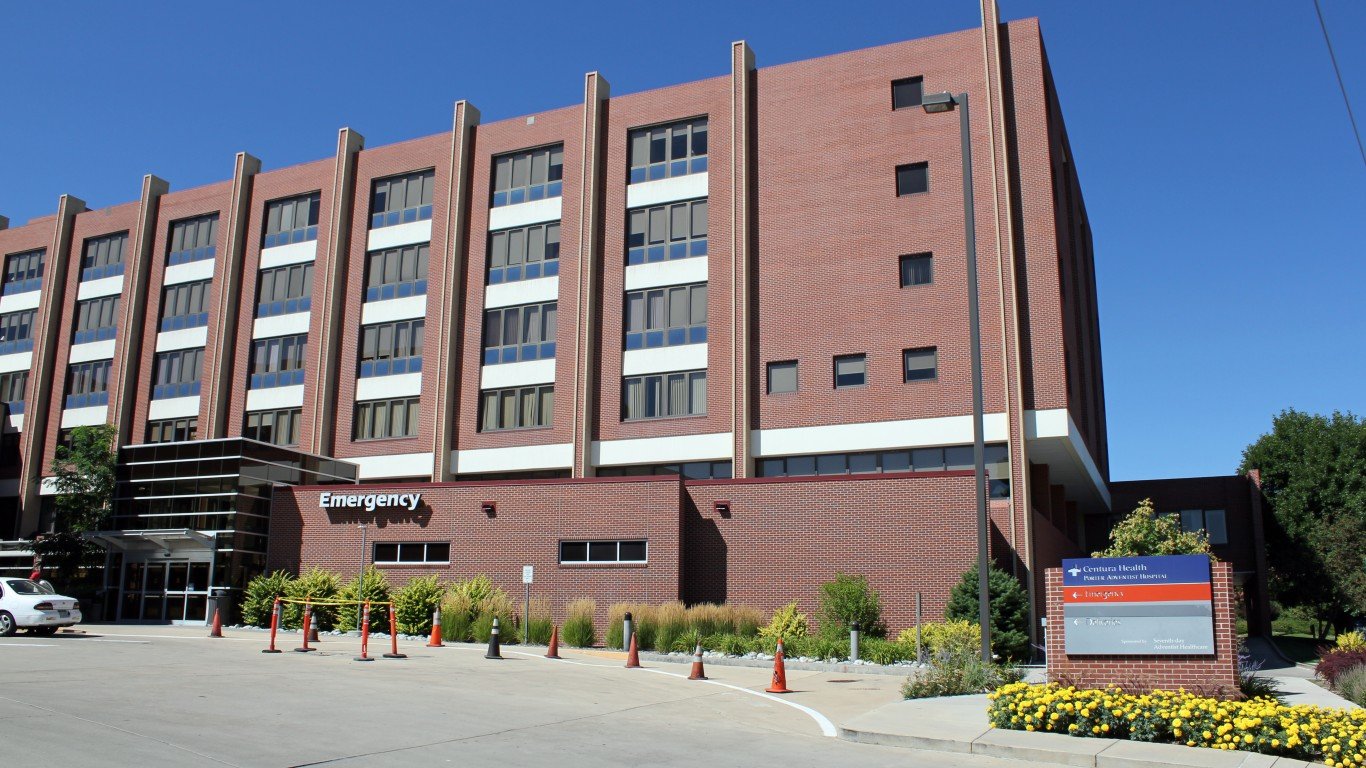The United States has been facing a doctors shortage for a few years, but the coronavirus crisis has exposed just how big the problem is. Medical institutions have been warning that there could be a shortage of up to 120,000 medical professionals by 2030 nationwide, according to research by the Association of American Medical Colleges.
To alleviate some of the current shortages, thousands of health care workers from all over the country, many of them retired, have asked to come back. But the labor shortage could worsen as the COVID-19 pandemic spreads as doctors and nurses inevitably fall sick.
Having access to a primary care doctor is more important than ever. Primary care physicians are typically the first contact for people with any health concern. A referral from a GP is required to be tested for COVID-19, even at drive-through test sites.
To find the number of doctors per capita in every state, 24/7 Tempo reviewed data on primary care physicians from the 2020 County Health Rankings & Roadmaps, a collaboration between the Robert Wood Johnson Foundation and the University of Wisconsin Population Health Institute.
Most of the states with the fewest doctors per capita are in the South. So far, the states with the most confirmed coronavirus cases also have relatively higher numbers of doctors per capita, and vice versa — with the exceptions of Texas and Georgia. These two states are in the top 10 states with fewest doctors per capita but in the top 15 of states with the most COVID-19 cases. In some places, there is also a shortage of hospitals. Amid the pandemic, these are the counties with the fewest hospitals.
The variation between states with the most and fewest doctors per capita is stark. It ranges from 112.8 doctors for every 100,000 people in the state with the most doctors per capita to 52.6 per 100,000 in the state with the fewest doctors per capita — less than half the concentration of the best state.
States with a lower doctor-to-resident ratio share some common attributes, including generally lower median household incomes and higher poverty rates than comparable U.S. figures. Among the 20 states with the fewest practicing physicians per capita, 14 have a poverty rate that is higher than the national average.
Many of the states with the fewest doctors per capita also have a relatively high uninsured population. Fifteen of the 20 states with the lowest concentration of doctors have uninsured rates that are higher than the U.S. average of 8.9% — in one state, almost a fifth of the adult population is without health coverage. On the other hand, 19 of the 20 states with the most doctors per capita have lower uninsured rates than the national rate.
The country is relying on doctors, health care workers and the medical system as a whole – which is often overwhelmed even in normal times – now more than ever to fight the intensifying outbreak.
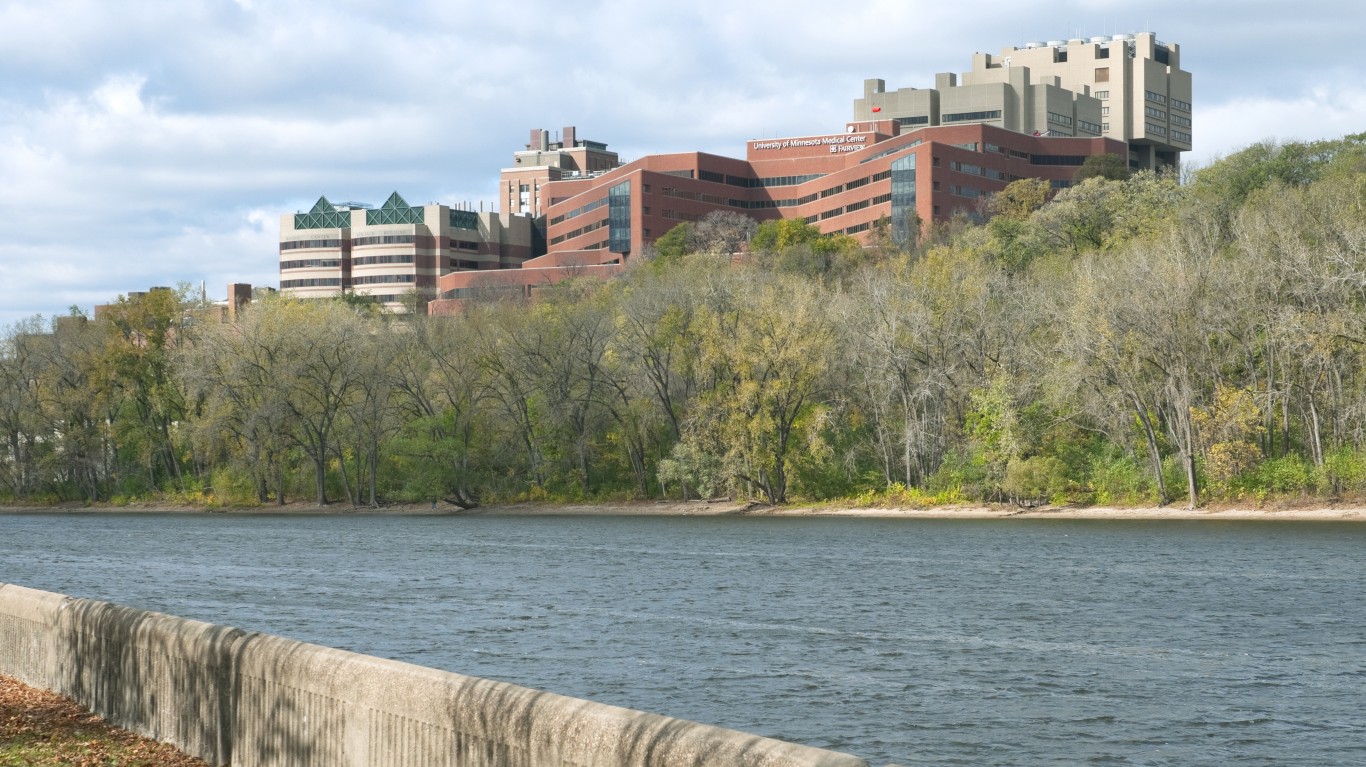
50. Mississippi
> Population: 2,986,530
> Primary care doctor to population ratio: 1 to 1,889
> Primary care doctors per 100,000 people: 52.9
> Total no. of ER doctors: 552 (17th lowest)
> COVID-19 confirmed cases: 1,358 as of April 3, 2020
> COVID-19 related deaths: 3 as of April 3, 2020
> Adults reporting poor or fair health: 24.1% (the highest)
> Adults without health insurance: 24.1% (6th highest)
> Adults with diabetes: 14.6% (2nd highest)

49. Nevada
> Population: 3,034,392
> Primary care doctor to population ratio: 1 to 1,768
> Primary care doctors per 100,000 people: 56.6
> Total no. of ER doctors: 645 (21st lowest)
> COVID-19 confirmed cases: 1,484 as of April 3, 2020
> COVID-19 related deaths: 34 as of April 3, 2020
> Adults reporting poor or fair health: 19.9% (10th highest)
> Adults without health insurance: 19.9% (7th highest)
> Adults with diabetes: 10.2% (22nd highest)
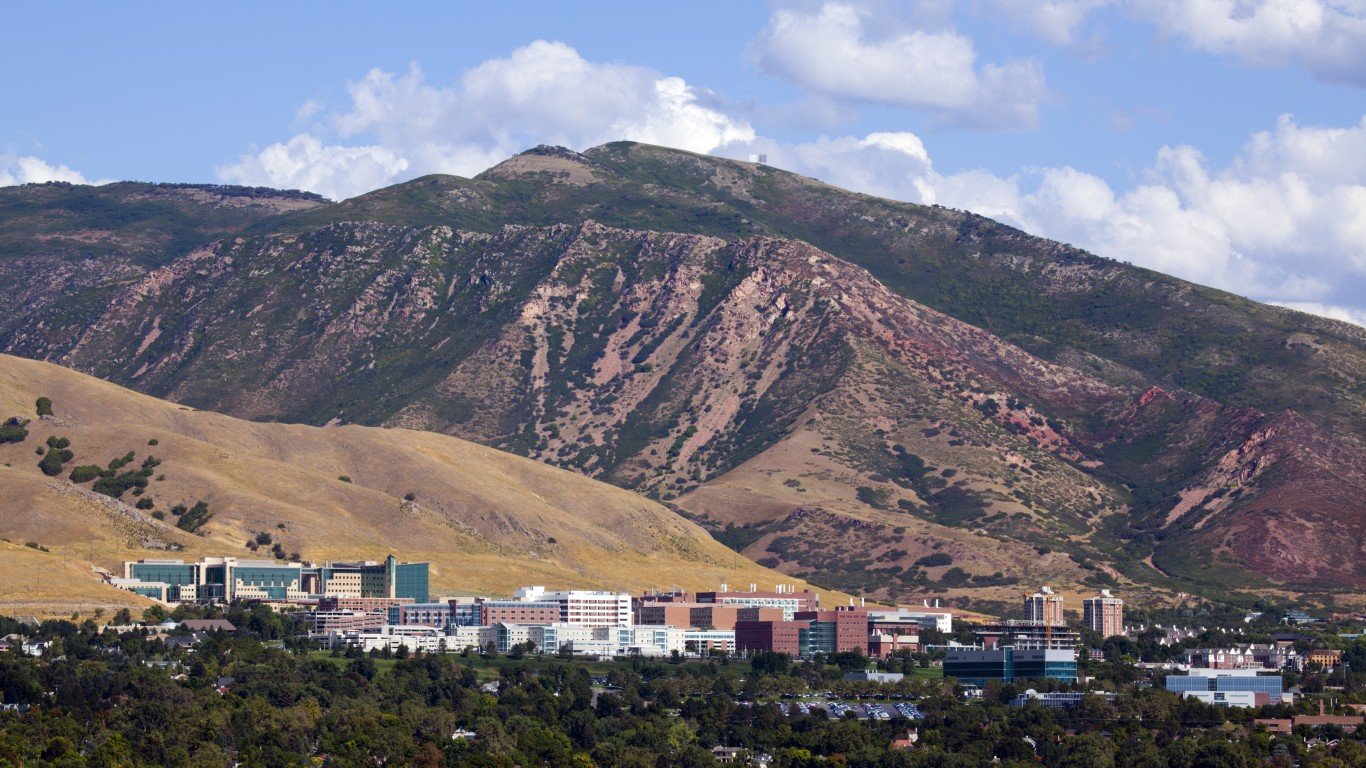
48. Utah
> Population: 3,161,105
> Primary care doctor to population ratio: 1 to 1,727
> Primary care doctors per 100,000 people: 57.9
> Total no. of ER doctors: 587 (19th lowest)
> COVID-19 confirmed cases: 1,095 as of April 3, 2020
> COVID-19 related deaths: 4 as of April 3, 2020
> Adults reporting poor or fair health: 13.9% (6th lowest)
> Adults without health insurance: 13.9% (17th highest)
> Adults with diabetes: 7.1% (2nd lowest)
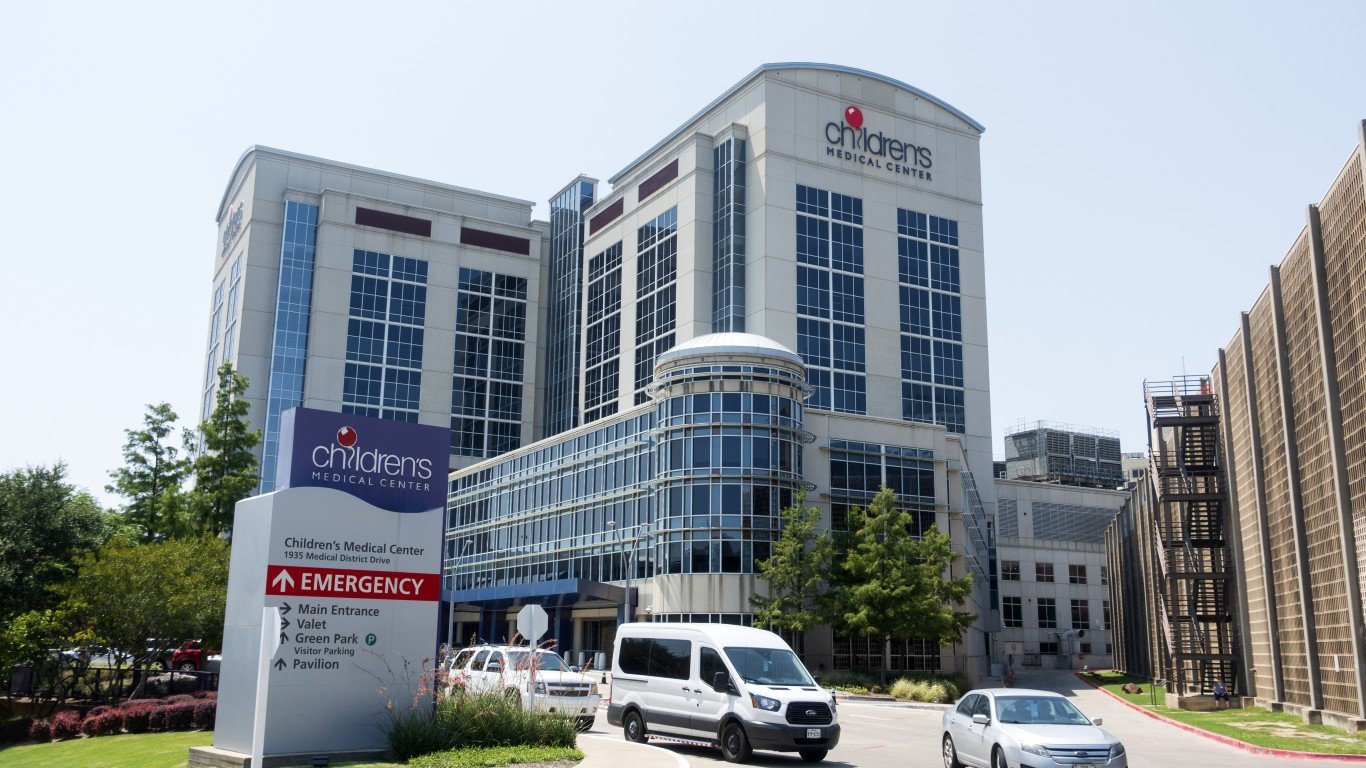
47. Texas
> Population: 28,701,845
> Primary care doctor to population ratio: 1 to 1,642
> Primary care doctors per 100,000 people: 60.9
> Total no. of ER doctors: 5,658 (2nd highest)
> COVID-19 confirmed cases: 5,368 as of April 3, 2020
> COVID-19 related deaths: 9 as of April 3, 2020
> Adults reporting poor or fair health: 20.8% (7th highest)
> Adults without health insurance: 20.8% (the highest)
> Adults with diabetes: 10.0% (25th highest)

46. Oklahoma
> Population: 3,943,079
> Primary care doctor to population ratio: 1 to 1,616
> Primary care doctors per 100,000 people: 61.9
> Total no. of ER doctors: 878 (23rd lowest)
> COVID-19 confirmed cases: 990 as of April 3, 2020
> COVID-19 related deaths: 25 as of April 3, 2020
> Adults reporting poor or fair health: 20.8% (8th highest)
> Adults without health insurance: 20.8% (2nd highest)
> Adults with diabetes: 12.2% (9th highest)

45. Alabama
> Population: 4,887,871
> Primary care doctor to population ratio: 1 to 1,543
> Primary care doctors per 100,000 people: 64.8
> Total no. of ER doctors: 743 (22nd lowest)
> COVID-19 confirmed cases: 1,315 as of April 3, 2020
> COVID-19 related deaths: 21 as of April 3, 2020
> Adults reporting poor or fair health: 22.0% (5th highest)
> Adults without health insurance: 22.0% (14th highest)
> Adults with diabetes: 14.2% (3rd highest)
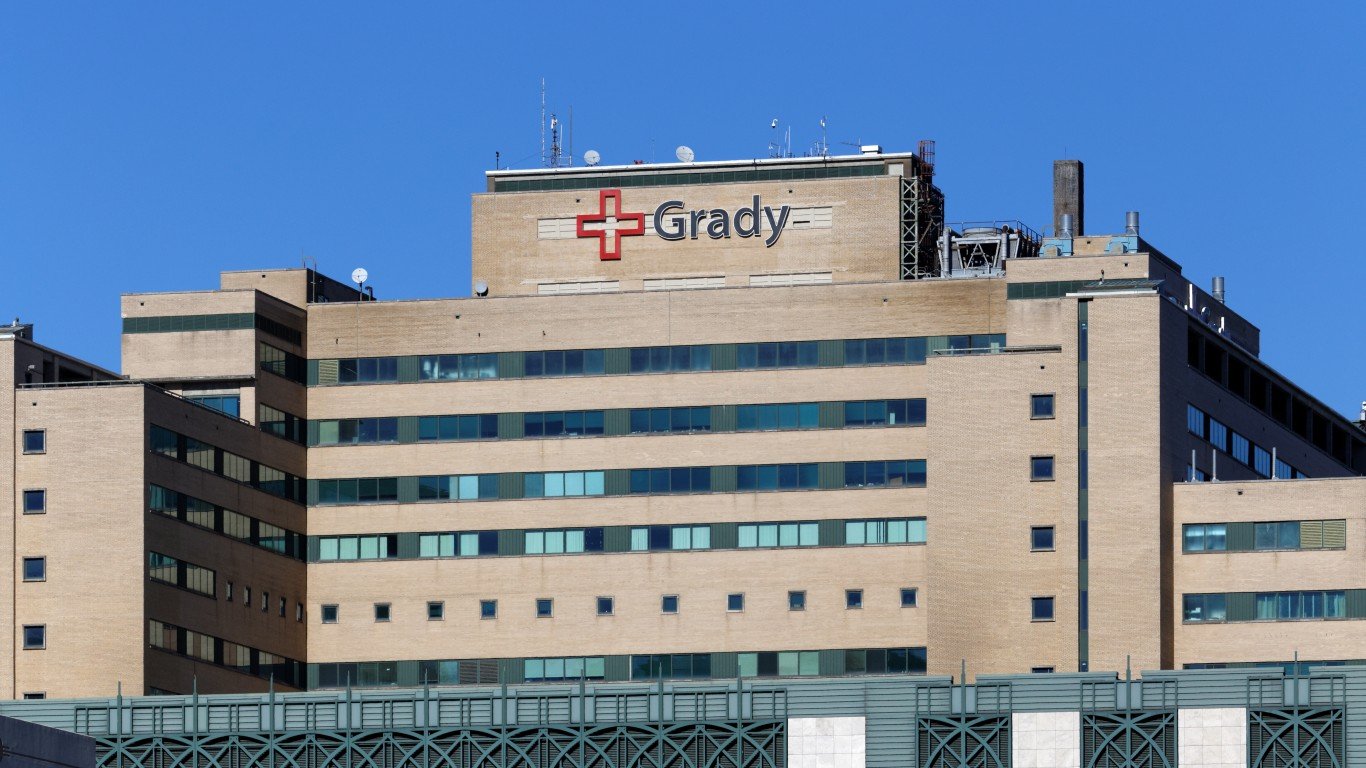
44. Georgia
> Population: 10,519,475
> Primary care doctor to population ratio: 1 to 1,528
> Primary care doctors per 100,000 people: 65.4
> Total no. of ER doctors: 1,989 (11th highest)
> COVID-19 confirmed cases: 5,831 as of April 3, 2020
> COVID-19 related deaths: 34 as of April 3, 2020
> Adults reporting poor or fair health: 18.0% (17th highest)
> Adults without health insurance: 18.0% (3rd highest)
> Adults with diabetes: 11.8% (11th highest)

43. Kentucky
> Population: 4,468,402
> Primary care doctor to population ratio: 1 to 1,523
> Primary care doctors per 100,000 people: 65.6
> Total no. of ER doctors: 1,042 (25th lowest)
> COVID-19 confirmed cases: 770 as of April 3, 2020
> COVID-19 related deaths: 24 as of April 3, 2020
> Adults reporting poor or fair health: 23.9% (3rd highest)
> Adults without health insurance: 23.9% (12th lowest)
> Adults with diabetes: 12.6% (8th highest)

42. Idaho
> Population: 1,754,208
> Primary care doctor to population ratio: 1 to 1,517
> Primary care doctors per 100,000 people: 65.9
> Total no. of ER doctors: 283 (7th lowest)
> COVID-19 confirmed cases: 891 as of April 3, 2020
> COVID-19 related deaths: 3 as of April 3, 2020
> Adults reporting poor or fair health: 14.6% (12th lowest)
> Adults without health insurance: 14.6% (8th highest)
> Adults with diabetes: 8.9% (13th lowest)

41. Indiana
> Population: 6,691,878
> Primary care doctor to population ratio: 1 to 1,511
> Primary care doctors per 100,000 people: 66.2
> Total no. of ER doctors: 1,379 (21st highest)
> COVID-19 confirmed cases: 3,435 as of April 3, 2020
> COVID-19 related deaths: 75 as of April 3, 2020
> Adults reporting poor or fair health: 19.8% (11th highest)
> Adults without health insurance: 19.8% (21st highest)
> Adults with diabetes: 11.9% (10th highest)

40. Arizona
> Population: 7,171,646
> Primary care doctor to population ratio: 1 to 1,505
> Primary care doctors per 100,000 people: 66.5
> Total no. of ER doctors: 1,530 (16th highest)
> COVID-19 confirmed cases: 1,937 as of April 3, 2020
> COVID-19 related deaths: 41 as of April 3, 2020
> Adults reporting poor or fair health: 18.6% (13th highest)
> Adults without health insurance: 18.6% (10th highest)
> Adults with diabetes: 9.7% (22nd lowest)
39. Arkansas
> Population: 3,013,825
> Primary care doctor to population ratio: 1 to 1,502
> Primary care doctors per 100,000 people: 66.6
> Total no. of ER doctors: 450 (13th lowest)
> COVID-19 confirmed cases: 683 as of April 3, 2020
> COVID-19 related deaths: 6 as of April 3, 2020
> Adults reporting poor or fair health: 23.2% (4th highest)
> Adults without health insurance: 23.2% (23rd highest)
> Adults with diabetes: 13.4% (4th highest)

38. South Carolina
> Population: 5,084,127
> Primary care doctor to population ratio: 1 to 1,498
> Primary care doctors per 100,000 people: 66.8
> Total no. of ER doctors: 1,252 (22nd highest)
> COVID-19 confirmed cases: 1,554 as of April 3, 2020
> COVID-19 related deaths: 18 as of April 3, 2020
> Adults reporting poor or fair health: 18.2% (15th highest)
> Adults without health insurance: 18.2% (11th highest)
> Adults with diabetes: 12.8% (5th highest)

37. Louisiana
> Population: 4,659,978
> Primary care doctor to population ratio: 1 to 1,496
> Primary care doctors per 100,000 people: 66.8
> Total no. of ER doctors: 1,243 (23rd highest)
> COVID-19 confirmed cases: 10,297 as of April 3, 2020
> COVID-19 related deaths: 344 as of April 3, 2020
> Adults reporting poor or fair health: 22.0% (6th highest)
> Adults without health insurance: 22.0% (25th highest)
> Adults with diabetes: 12.8% (5th highest)
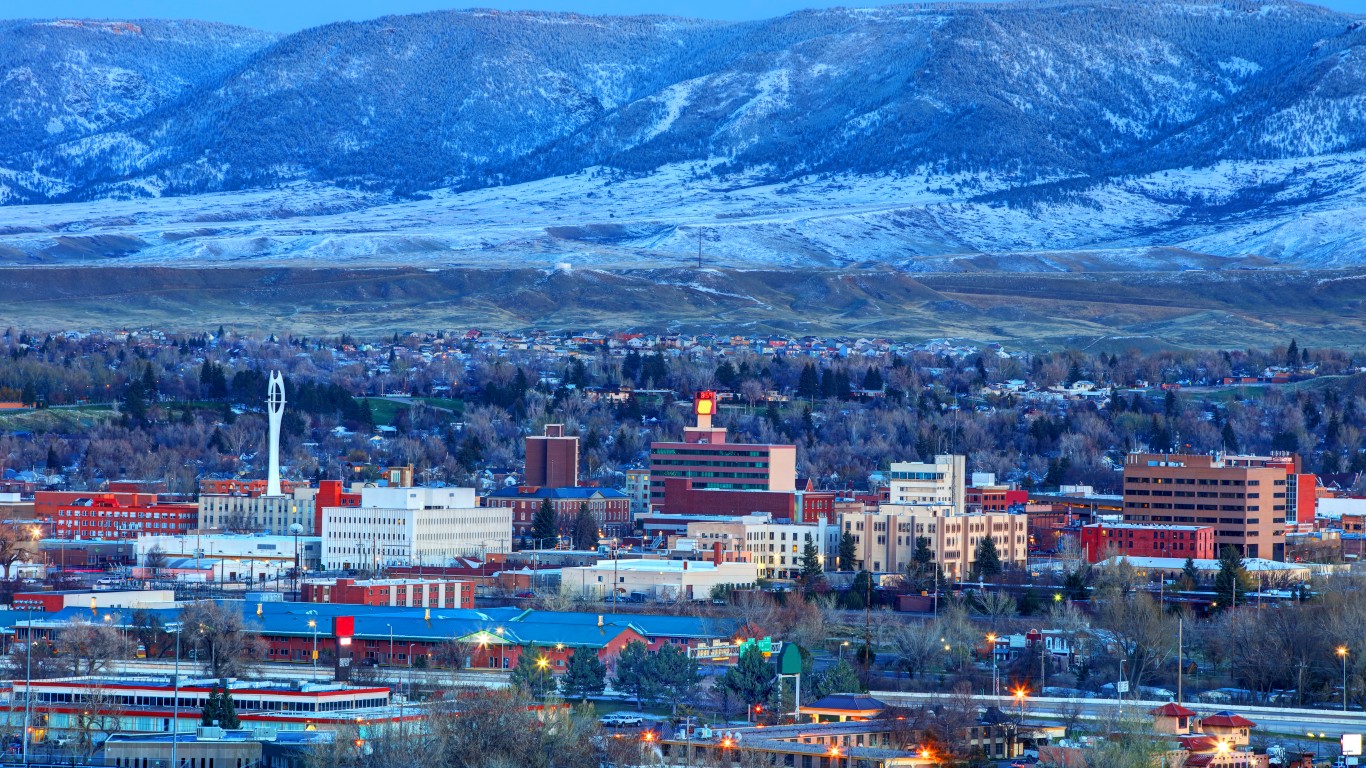
36. Wyoming
> Population: 577,737
> Primary care doctor to population ratio: 1 to 1,474
> Primary care doctors per 100,000 people: 67.8
> Total no. of ER doctors: 133 (3rd lowest)
> COVID-19 confirmed cases: 162 as of April 3, 2020
> COVID-19 related deaths: No reports as of April 3, 2020
> Adults reporting poor or fair health: 15.0% (15th lowest)
> Adults without health insurance: 15.0% (11th highest)
> Adults with diabetes: 8.7% (8th lowest)
35. Missouri
> Population: 6,126,452
> Primary care doctor to population ratio: 1 to 1,430
> Primary care doctors per 100,000 people: 69.9
> Total no. of ER doctors: 1,537 (15th highest)
> COVID-19 confirmed cases: 1,863 as of April 3, 2020
> COVID-19 related deaths: 14 as of April 3, 2020
> Adults reporting poor or fair health: 18.0% (18th highest)
> Adults without health insurance: 18.0% (17th highest)
> Adults with diabetes: 11.6% (13th highest)
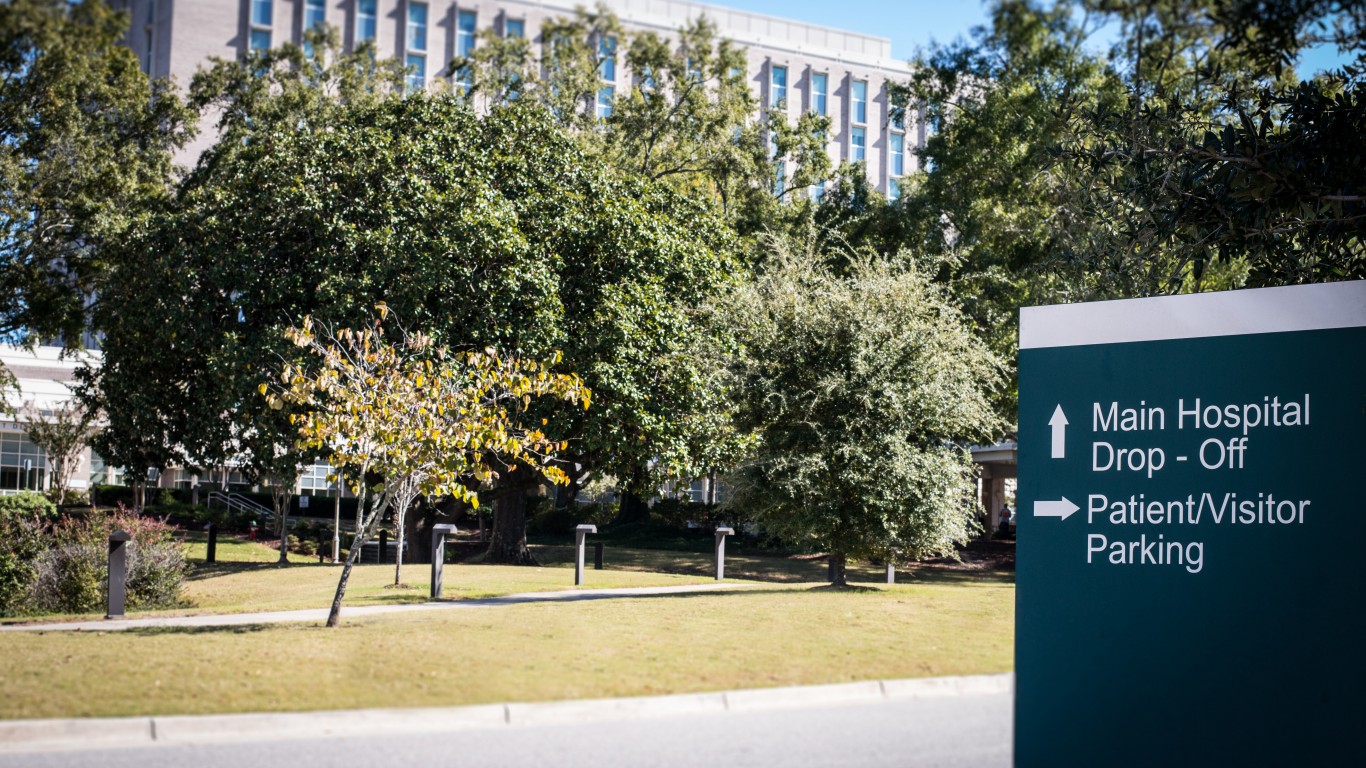
34. North Carolina
> Population: 10,383,620
> Primary care doctor to population ratio: 1 to 1,412
> Primary care doctors per 100,000 people: 70.8
> Total no. of ER doctors: 2,422 (9th highest)
> COVID-19 confirmed cases: 2,147 as of April 3, 2020
> COVID-19 related deaths: 6 as of April 3, 2020
> Adults reporting poor or fair health: 18.5% (14th highest)
> Adults without health insurance: 18.5% (9th highest)
> Adults with diabetes: 11.2% (15th highest)
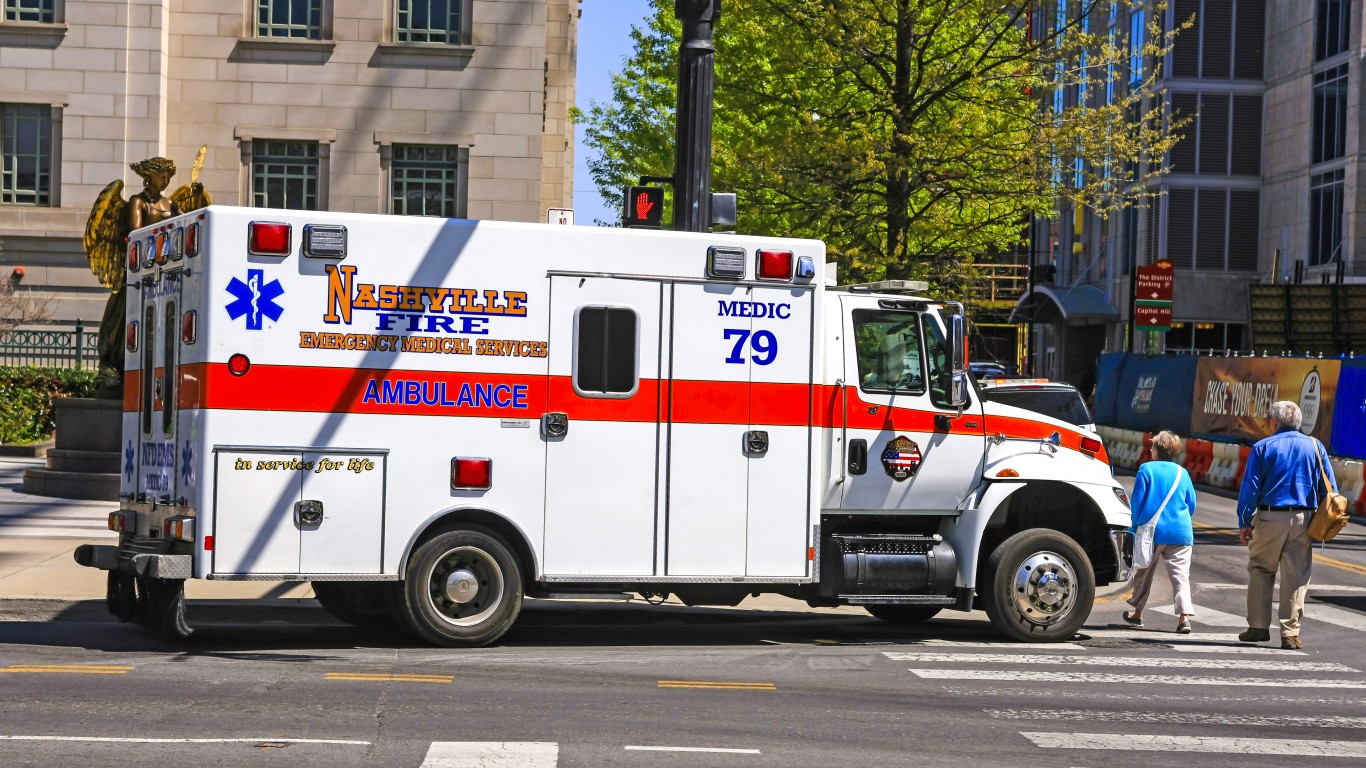
33. Tennessee
> Population: 6,770,010
> Primary care doctor to population ratio: 1 to 1,396
> Primary care doctors per 100,000 people: 71.6
> Total no. of ER doctors: 1,233 (24th highest)
> COVID-19 confirmed cases: 2,845 as of April 3, 2020
> COVID-19 related deaths: 25 as of April 3, 2020
> Adults reporting poor or fair health: 19.7% (12th highest)
> Adults without health insurance: 19.7% (13th highest)
> Adults with diabetes: 12.8% (5th highest)

32. Delaware
> Population: 967,171
> Primary care doctor to population ratio: 1 to 1,392
> Primary care doctors per 100,000 people: 71.8
> Total no. of ER doctors: 310 (9th lowest)
> COVID-19 confirmed cases: 393 as of April 3, 2020
> COVID-19 related deaths: 20 as of April 3, 2020
> Adults reporting poor or fair health: 18.0% (20th highest)
> Adults without health insurance: 18.0% (14th lowest)
> Adults with diabetes: 11.5% (14th highest)

31. Florida
> Population: 21,299,325
> Primary care doctor to population ratio: 1 to 1,379
> Primary care doctors per 100,000 people: 72.5
> Total no. of ER doctors: 4,259 (4th highest)
> COVID-19 confirmed cases: 9,585 as of April 3, 2020
> COVID-19 related deaths: 1,152 as of April 3, 2020
> Adults reporting poor or fair health: 17.5% (23rd highest)
> Adults without health insurance: 17.5% (4th highest)
> Adults with diabetes: 10.6% (18th highest)

30. Iowa
> Population: 3,156,145
> Primary care doctor to population ratio: 1 to 1,372
> Primary care doctors per 100,000 people: 72.9
> Total no. of ER doctors: 506 (16th lowest)
> COVID-19 confirmed cases: 699 as of April 3, 2020
> COVID-19 related deaths: 4 as of April 3, 2020
> Adults reporting poor or fair health: 14.5% (11th lowest)
> Adults without health insurance: 14.5% (6th lowest)
> Adults with diabetes: 9.7% (22nd lowest)
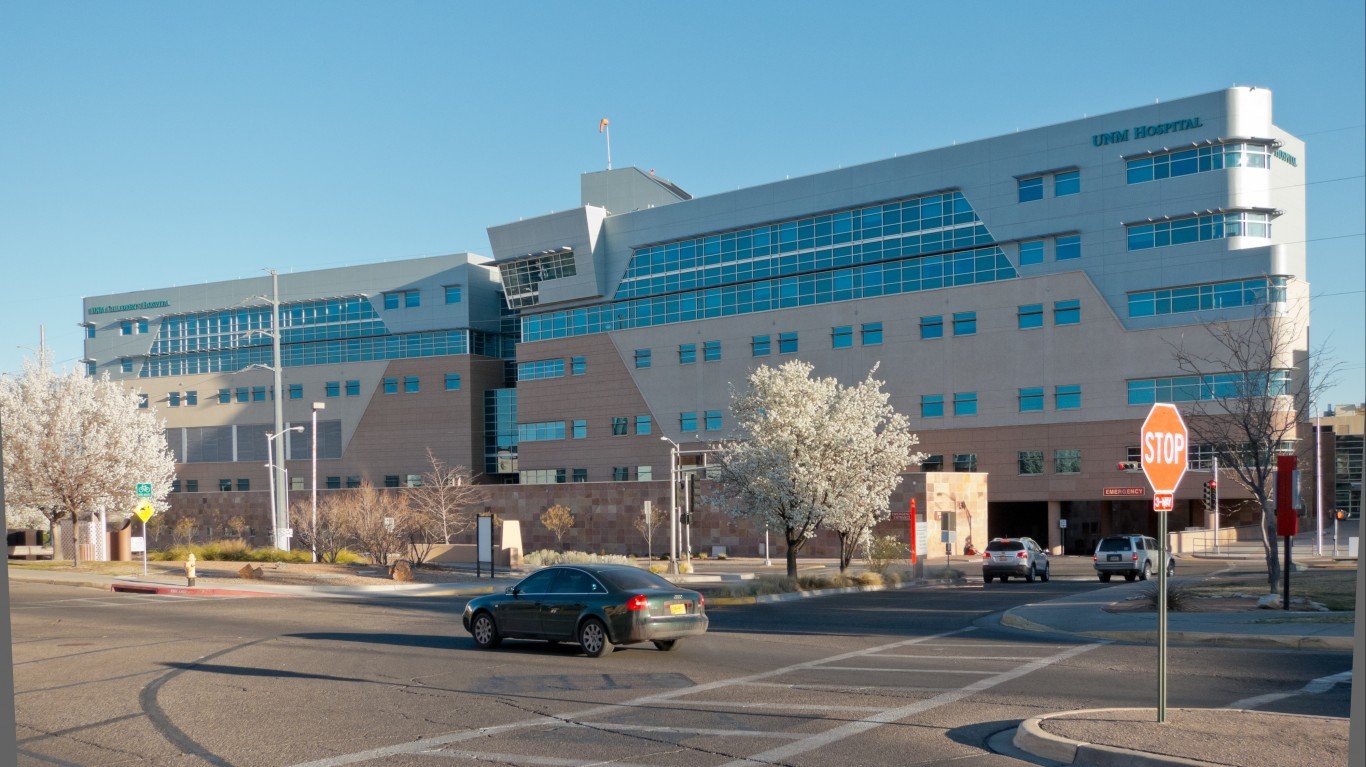
29. New Mexico
> Population: 2,095,428
> Primary care doctor to population ratio: 1 to 1,339
> Primary care doctors per 100,000 people: 74.7
> Total no. of ER doctors: 567 (18th lowest)
> COVID-19 confirmed cases: 442 as of April 3, 2020
> COVID-19 related deaths: 5 as of April 3, 2020
> Adults reporting poor or fair health: 20.6% (9th highest)
> Adults without health insurance: 20.6% (16th highest)
> Adults with diabetes: 8.9% (13th lowest)

28. Nebraska
> Population: 1,929,268
> Primary care doctor to population ratio: 1 to 1,327
> Primary care doctors per 100,000 people: 75.4
> Total no. of ER doctors: 307 (8th lowest)
> COVID-19 confirmed cases: 278 as of April 3, 2020
> COVID-19 related deaths: No reports as of April 3, 2020
> Adults reporting poor or fair health: 14.4% (9th lowest)
> Adults without health insurance: 14.4% (21st highest)
> Adults with diabetes: 9.4% (18th lowest)

27. South Dakota
> Population: 882,235
> Primary care doctor to population ratio: 1 to 1,322
> Primary care doctors per 100,000 people: 75.7
> Total no. of ER doctors: 105 (the lowest)
> COVID-19 confirmed cases: 187 as of April 3, 2020
> COVID-19 related deaths: No reports as of April 3, 2020
> Adults reporting poor or fair health: 13.4% (4th lowest)
> Adults without health insurance: 13.4% (15th highest)
> Adults with diabetes: 9.9% (25th lowest)

26. Virginia
> Population: 8,517,685
> Primary care doctor to population ratio: 1 to 1,319
> Primary care doctors per 100,000 people: 75.8
> Total no. of ER doctors: 1,944 (12th highest)
> COVID-19 confirmed cases: 2,012 as of April 3, 2020
> COVID-19 related deaths: 31 as of April 3, 2020
> Adults reporting poor or fair health: 15.8% (19th lowest)
> Adults without health insurance: 15.8% (19th highest)
> Adults with diabetes: 10.5% (20th highest)

25. Ohio
> Population: 11,689,442
> Primary care doctor to population ratio: 1 to 1,312
> Primary care doctors per 100,000 people: 76.2
> Total no. of ER doctors: 3,661 (7th highest)
> COVID-19 confirmed cases: 2,902 as of April 3, 2020
> COVID-19 related deaths: 68 as of April 3, 2020
> Adults reporting poor or fair health: 18.0% (19th highest)
> Adults without health insurance: 18.0% (18th lowest)
> Adults with diabetes: 11.8% (11th highest)

24. North Dakota
> Population: 760,077
> Primary care doctor to population ratio: 1 to 1,305
> Primary care doctors per 100,000 people: 76.6
> Total no. of ER doctors: 117 (2nd lowest)
> COVID-19 confirmed cases: 173 as of April 3, 2020
> COVID-19 related deaths: No reports as of April 3, 2020
> Adults reporting poor or fair health: 15.1% (17th lowest)
> Adults without health insurance: 15.1% (22nd lowest)
> Adults with diabetes: 9.0% (14th lowest)

23. Kansas
> Population: 2,911,510
> Primary care doctor to population ratio: 1 to 1,295
> Primary care doctors per 100,000 people: 77.2
> Total no. of ER doctors: 463 (14th lowest)
> COVID-19 confirmed cases: 620 as of April 3, 2020
> COVID-19 related deaths: 8 as of April 3, 2020
> Adults reporting poor or fair health: 16.1% (20th lowest)
> Adults without health insurance: 16.1% (19th highest)
> Adults with diabetes: 10.1% (24th highest)

22. West Virginia
> Population: 1,805,832
> Primary care doctor to population ratio: 1 to 1,287
> Primary care doctors per 100,000 people: 77.7
> Total no. of ER doctors: 606 (20th lowest)
> COVID-19 confirmed cases: 217 as of April 3, 2020
> COVID-19 related deaths: No reports as of April 3, 2020
> Adults reporting poor or fair health: 23.9% (2nd highest)
> Adults without health insurance: 23.9% (17th lowest)
> Adults with diabetes: 14.9% (the highest)
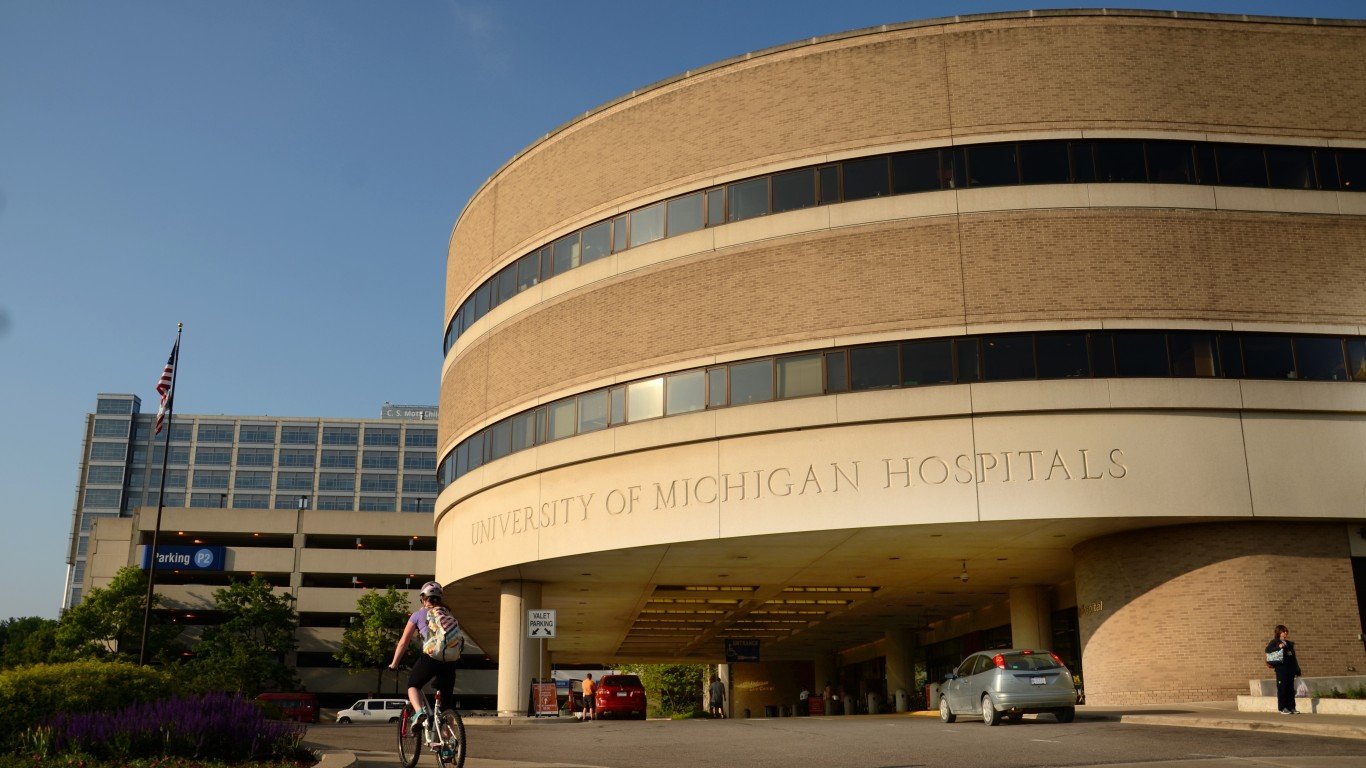
21. Michigan
> Population: 9,995,915
> Primary care doctor to population ratio: 1 to 1,277
> Primary care doctors per 100,000 people: 78.3
> Total no. of ER doctors: 4,137 (5th highest)
> COVID-19 confirmed cases: 10,791 as of April 3, 2020
> COVID-19 related deaths: 389 as of April 3, 2020
> Adults reporting poor or fair health: 17.4% (24th highest)
> Adults without health insurance: 17.4% (9th lowest)
> Adults with diabetes: 10.8% (16th highest)
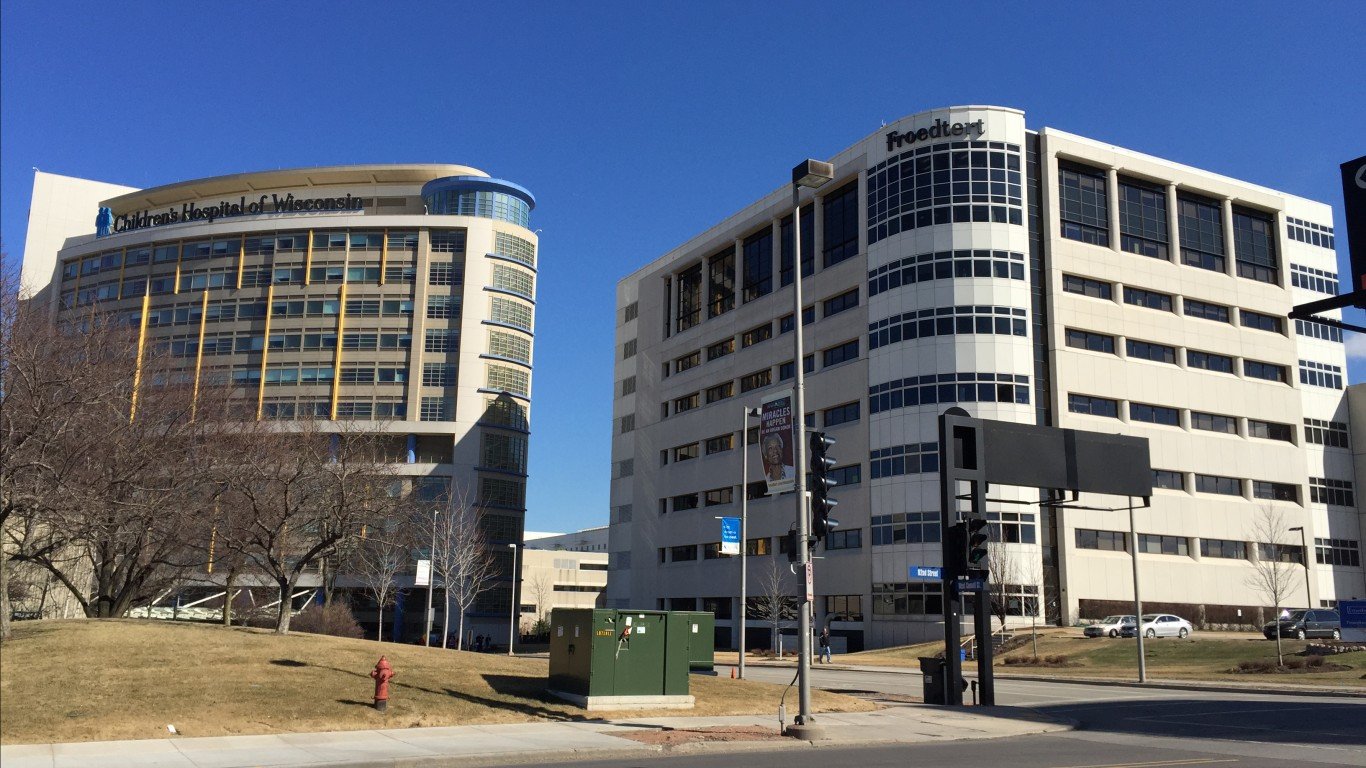
20. Wisconsin
> Population: 5,813,568
> Primary care doctor to population ratio: 1 to 1,270
> Primary care doctors per 100,000 people: 78.7
> Total no. of ER doctors: 1,390 (20th highest)
> COVID-19 confirmed cases: 1,756 as of April 3, 2020
> COVID-19 related deaths: 29 as of April 3, 2020
> Adults reporting poor or fair health: 16.7% (23rd lowest)
> Adults without health insurance: 16.7% (11th lowest)
> Adults with diabetes: 9.3% (17th lowest)

19. California
> Population: 39,557,045
> Primary care doctor to population ratio: 1 to 1,261
> Primary care doctors per 100,000 people: 79.3
> Total no. of ER doctors: 8,003 (the highest)
> COVID-19 confirmed cases: 11,206 as of April 3, 2020
> COVID-19 related deaths: 227 as of April 3, 2020
> Adults reporting poor or fair health: 17.2% (25th highest)
> Adults without health insurance: 17.2% (21st lowest)
> Adults with diabetes: 8.6% (7th lowest)

18. Illinois
> Population: 12,741,080
> Primary care doctor to population ratio: 1 to 1,250
> Primary care doctors per 100,000 people: 80.0
> Total no. of ER doctors: 3,529 (8th highest)
> COVID-19 confirmed cases: 7,697 as of April 3, 2020
> COVID-19 related deaths: 153 as of April 3, 2020
> Adults reporting poor or fair health: 17.2% (25th lowest)
> Adults without health insurance: 17.2% (19th lowest)
> Adults with diabetes: 9.9% (25th lowest)

17. Montana
> Population: 1,062,305
> Primary care doctor to population ratio: 1 to 1,248
> Primary care doctors per 100,000 people: 80.2
> Total no. of ER doctors: 222 (6th lowest)
> COVID-19 confirmed cases: 243 as of April 3, 2020
> COVID-19 related deaths: 3 as of April 3, 2020
> Adults reporting poor or fair health: 14.7% (13th lowest)
> Adults without health insurance: 14.7% (23rd highest)
> Adults with diabetes: 8.1% (4th lowest)

16. Pennsylvania
> Population: 12,807,060
> Primary care doctor to population ratio: 1 to 1,237
> Primary care doctors per 100,000 people: 80.8
> Total no. of ER doctors: 4,048 (6th highest)
> COVID-19 confirmed cases: 8,570 as of April 3, 2020
> COVID-19 related deaths: 82 as of April 3, 2020
> Adults reporting poor or fair health: 17.5% (22nd highest)
> Adults without health insurance: 17.5% (11th lowest)
> Adults with diabetes: 10.6% (18th highest)
15. Colorado
> Population: 5,695,564
> Primary care doctor to population ratio: 1 to 1,219
> Primary care doctors per 100,000 people: 82.0
> Total no. of ER doctors: 1,462 (18th highest)
> COVID-19 confirmed cases: 3,742 as of April 3, 2020
> COVID-19 related deaths: 80 as of April 3, 2020
> Adults reporting poor or fair health: 14.5% (10th lowest)
> Adults without health insurance: 14.5% (24th lowest)
> Adults with diabetes: 6.3% (the lowest)
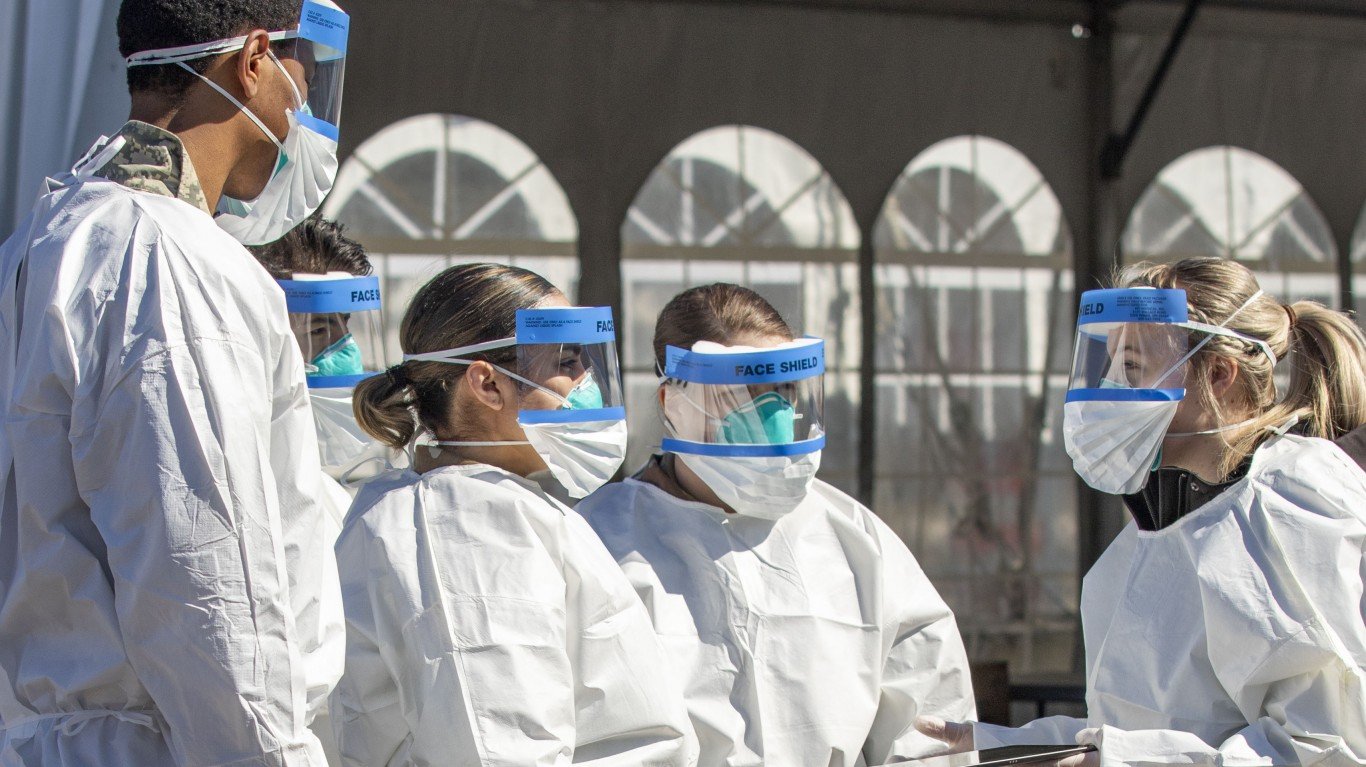
14. New York
> Population: 19,542,209
> Primary care doctor to population ratio: 1 to 1,219
> Primary care doctors per 100,000 people: 82.1
> Total no. of ER doctors: 5,417 (3rd highest)
> COVID-19 confirmed cases: 102,863 as of April 3, 2020
> COVID-19 related deaths: 2,916 as of April 3, 2020
> Adults reporting poor or fair health: 16.6% (22nd lowest)
> Adults without health insurance: 16.6% (9th lowest)
> Adults with diabetes: 9.8% (23rd lowest)

13. Connecticut
> Population: 3,572,665
> Primary care doctor to population ratio: 1 to 1,202
> Primary care doctors per 100,000 people: 83.2
> Total no. of ER doctors: 941 (24th lowest)
> COVID-19 confirmed cases: 3,824 as of April 3, 2020
> COVID-19 related deaths: 108 as of April 3, 2020
> Adults reporting poor or fair health: 13.8% (5th lowest)
> Adults without health insurance: 13.8% (7th lowest)
> Adults with diabetes: 8.9% (13th lowest)
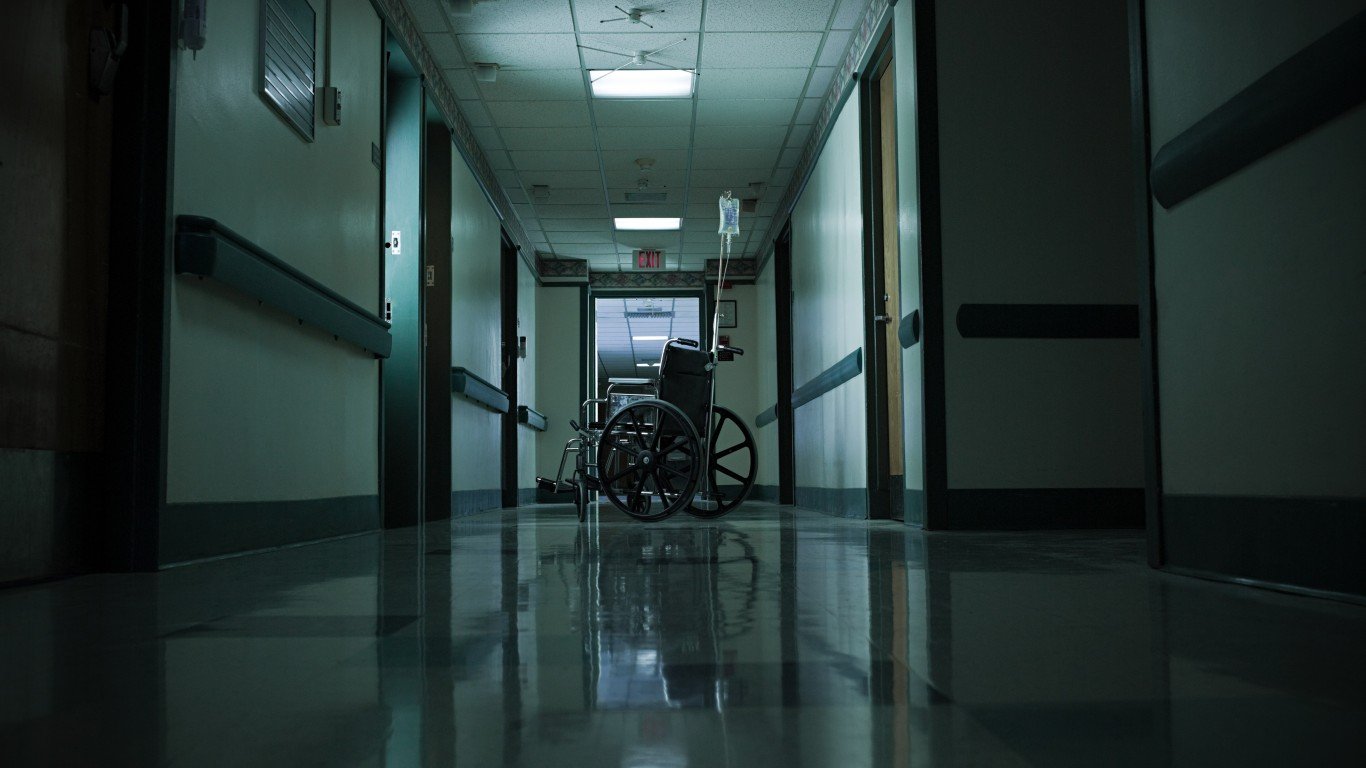
12. New Jersey
> Population: 8,908,520
> Primary care doctor to population ratio: 1 to 1,189
> Primary care doctors per 100,000 people: 84.1
> Total no. of ER doctors: 1,928 (13th highest)
> COVID-19 confirmed cases: 25,590 as of April 3, 2020
> COVID-19 related deaths: 532 as of April 3, 2020
> Adults reporting poor or fair health: 17.7% (21st highest)
> Adults without health insurance: 17.7% (23rd lowest)
> Adults with diabetes: 9.5% (20th lowest)

11. Washington
> Population: 7,535,591
> Primary care doctor to population ratio: 1 to 1,183
> Primary care doctors per 100,000 people: 84.5
> Total no. of ER doctors: 1,613 (14th highest)
> COVID-19 confirmed cases: 6,597 as of April 3, 2020
> COVID-19 related deaths: 268 as of April 3, 2020
> Adults reporting poor or fair health: 15.6% (18th lowest)
> Adults without health insurance: 15.6% (17th lowest)
> Adults with diabetes: 8.8% (9th lowest)

10. Hawaii
> Population: 1,420,491
> Primary care doctor to population ratio: 1 to 1,142
> Primary care doctors per 100,000 people: 87.6
> Total no. of ER doctors: 413 (12th lowest)
> COVID-19 confirmed cases: 283 as of April 3, 2020
> COVID-19 related deaths: No reports as of April 3, 2020
> Adults reporting poor or fair health: 14.2% (7th lowest)
> Adults without health insurance: 14.2% (4th lowest)
> Adults with diabetes: 10.3% (21st highest)

9. Maryland
> Population: 6,042,718
> Primary care doctor to population ratio: 1 to 1,141
> Primary care doctors per 100,000 people: 87.7
> Total no. of ER doctors: 1,494 (17th highest)
> COVID-19 confirmed cases: 2,758 as of April 3, 2020
> COVID-19 related deaths: 37 as of April 3, 2020
> Adults reporting poor or fair health: 14.9% (14th lowest)
> Adults without health insurance: 14.9% (15th lowest)
> Adults with diabetes: 10.7% (17th highest)

8. Minnesota
> Population: 5,611,179
> Primary care doctor to population ratio: 1 to 1,118
> Primary care doctors per 100,000 people: 89.4
> Total no. of ER doctors: 1,442 (19th highest)
> COVID-19 confirmed cases: 788 as of April 3, 2020
> COVID-19 related deaths: 17 as of April 3, 2020
> Adults reporting poor or fair health: 12.1% (the lowest)
> Adults without health insurance: 12.1% (5th lowest)
> Adults with diabetes: 8.3% (5th lowest)
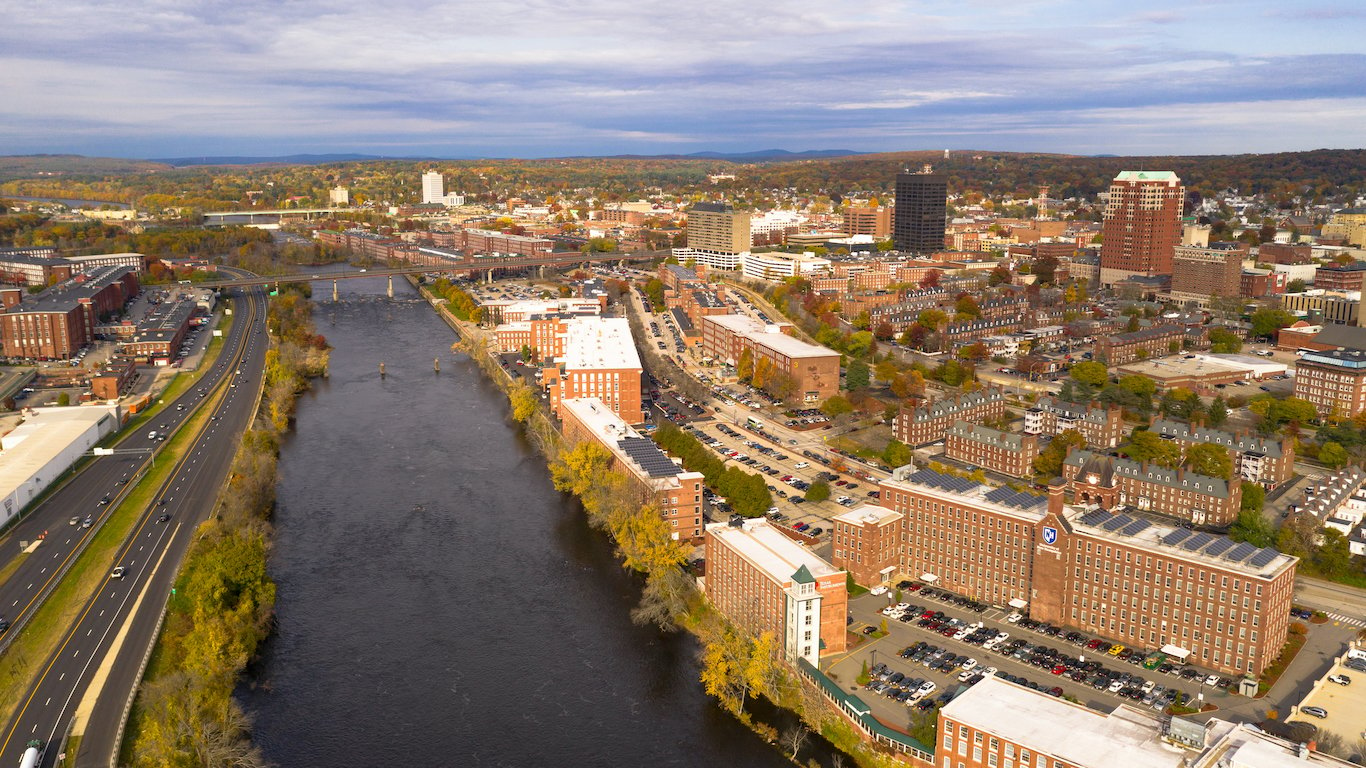
7. New Hampshire
> Population: 1,356,458
> Primary care doctor to population ratio: 1 to 1,102
> Primary care doctors per 100,000 people: 90.8
> Total no. of ER doctors: 347 (10th lowest)
> COVID-19 confirmed cases: 479 as of April 3, 2020
> COVID-19 related deaths: No reports as of April 3, 2020
> Adults reporting poor or fair health: 13.1% (3rd lowest)
> Adults without health insurance: 13.1% (14th lowest)
> Adults with diabetes: 9.3% (17th lowest)
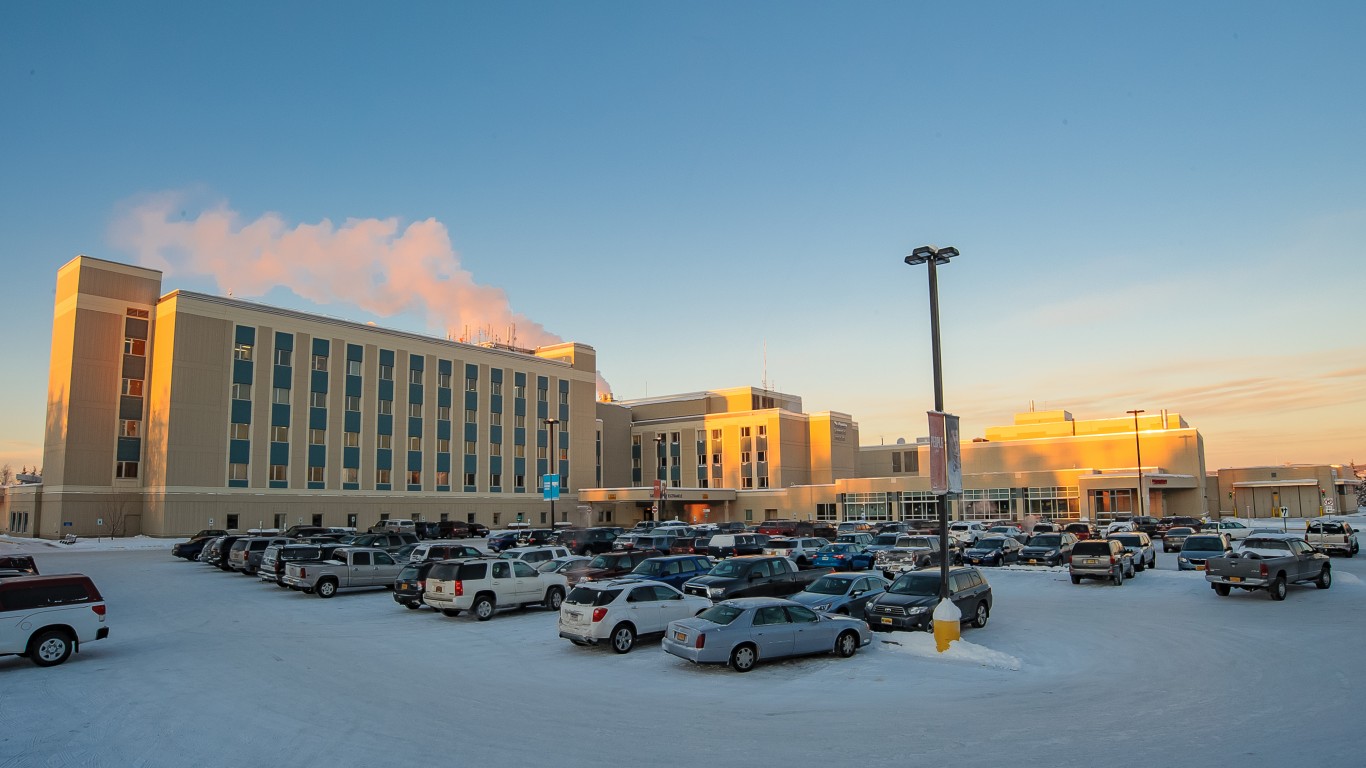
6. Alaska
> Population: 737,438
> Primary care doctor to population ratio: 1 to 1,099
> Primary care doctors per 100,000 people: 91.0
> Total no. of ER doctors: 199 (5th lowest)
> COVID-19 confirmed cases: 147 as of April 3, 2020
> COVID-19 related deaths: No reports as of April 3, 2020
> Adults reporting poor or fair health: 18.1% (16th highest)
> Adults without health insurance: 18.1% (5th highest)
> Adults with diabetes: 7.9% (3rd lowest)

5. Oregon
> Population: 4,190,713
> Primary care doctor to population ratio: 1 to 1,063
> Primary care doctors per 100,000 people: 94.0
> Total no. of ER doctors: 1,079 (25th highest)
> COVID-19 confirmed cases: 826 as of April 3, 2020
> COVID-19 related deaths: 17 as of April 3, 2020
> Adults reporting poor or fair health: 16.7% (24th lowest)
> Adults without health insurance: 16.7% (20th lowest)
> Adults with diabetes: 9.3% (17th lowest)
4. Rhode Island
> Population: 1,057,315
> Primary care doctor to population ratio: 1 to 1,029
> Primary care doctors per 100,000 people: 97.2
> Total no. of ER doctors: 469 (15th lowest)
> COVID-19 confirmed cases: 657 as of April 3, 2020
> COVID-19 related deaths: 10 as of April 3, 2020
> Adults reporting poor or fair health: 16.4% (21st lowest)
> Adults without health insurance: 16.4% (4th lowest)
> Adults with diabetes: 9.5% (20th lowest)

3. Massachusetts
> Population: 6,902,149
> Primary care doctor to population ratio: 1 to 968
> Primary care doctors per 100,000 people: 103.3
> Total no. of ER doctors: 2,223 (10th highest)
> COVID-19 confirmed cases: 8,966 as of April 3, 2020
> COVID-19 related deaths: 152 as of April 3, 2020
> Adults reporting poor or fair health: 14.4% (8th lowest)
> Adults without health insurance: 14.4% (the lowest)
> Adults with diabetes: 8.9% (13th lowest)
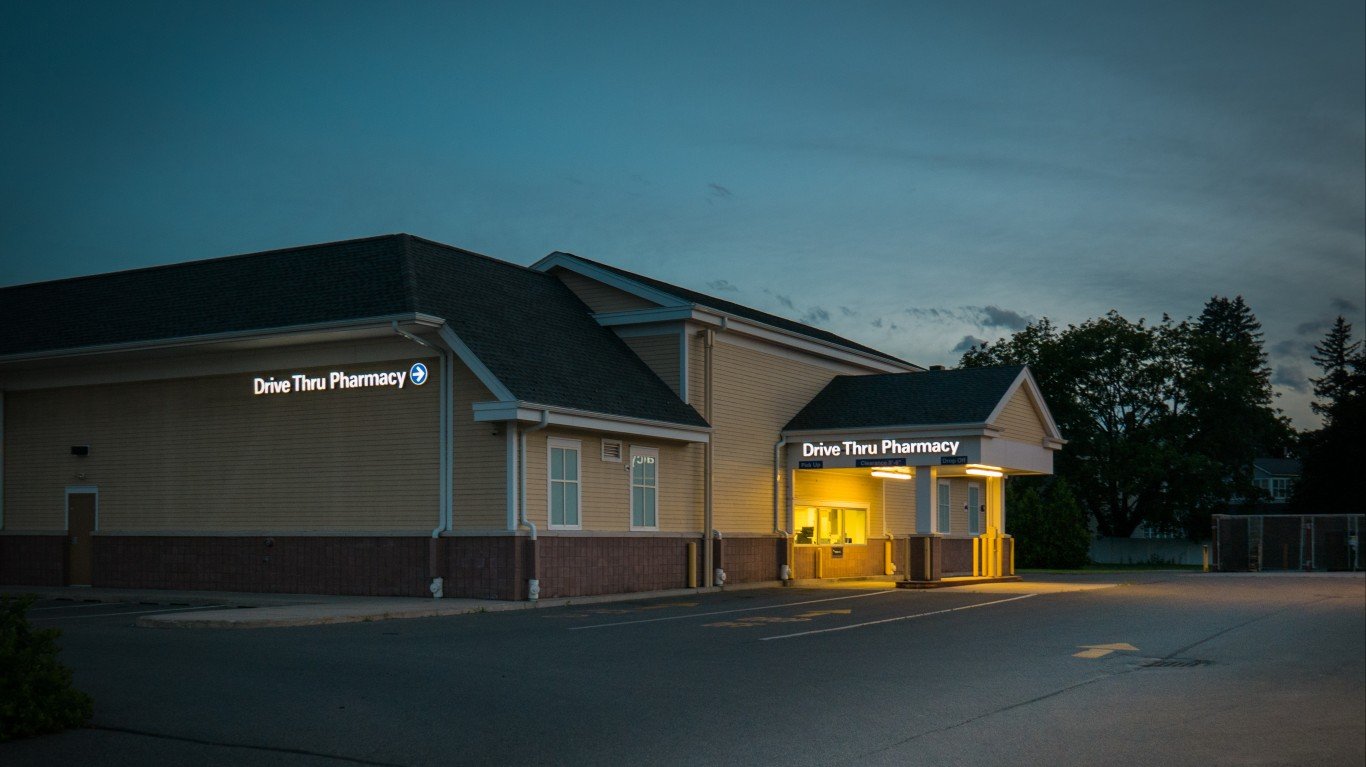
2. Maine
> Population: 1,338,404
> Primary care doctor to population ratio: 1 to 898
> Primary care doctors per 100,000 people: 111.4
> Total no. of ER doctors: 399 (11th lowest)
> COVID-19 confirmed cases: 432 as of April 3, 2020
> COVID-19 related deaths: 5 as of April 3, 2020
> Adults reporting poor or fair health: 15.0% (16th lowest)
> Adults without health insurance: 15.0% (25th highest)
> Adults with diabetes: 10.2% (22nd highest)
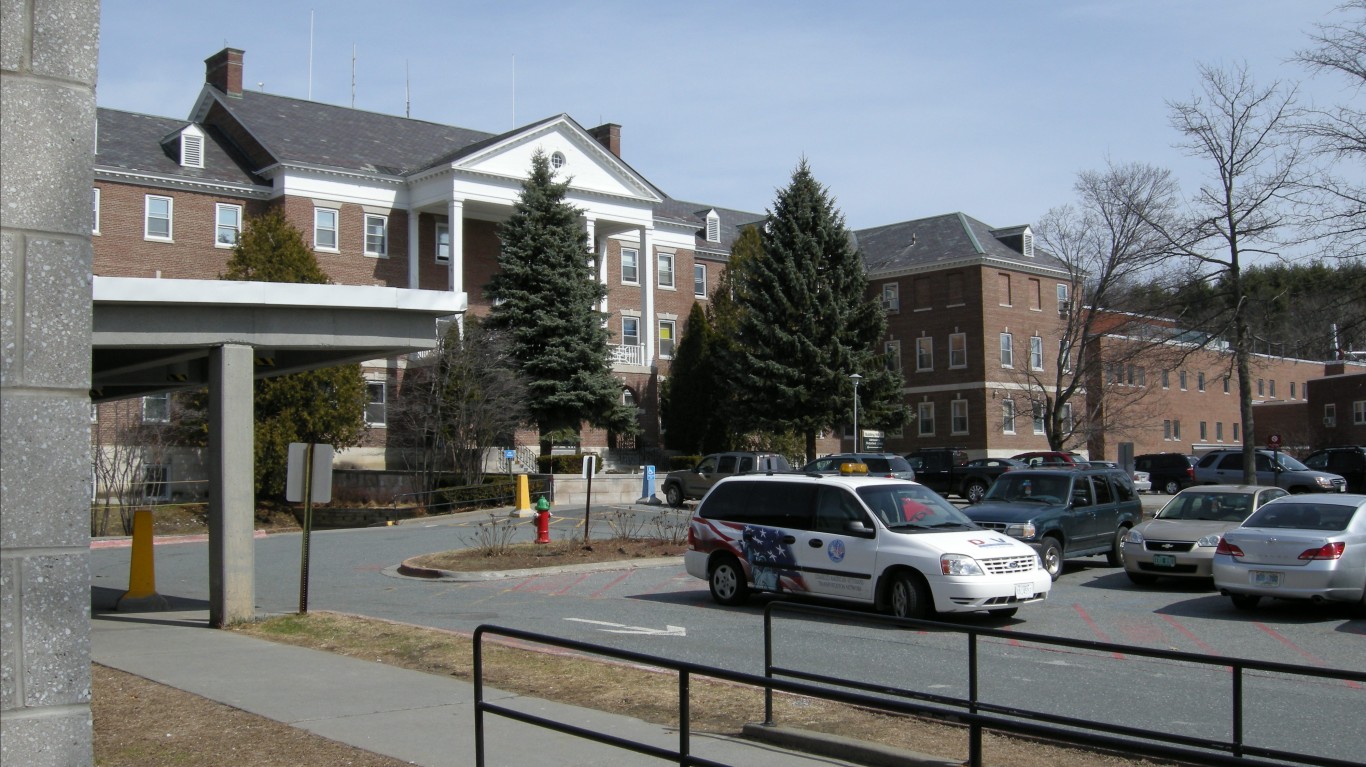
1. Vermont
> Population: 626,299
> Primary care doctor to population ratio: 1 to 886
> Primary care doctors per 100,000 people: 112.9
> Total no. of ER doctors: 152 (4th lowest)
> COVID-19 confirmed cases: 338 as of April 3, 2020
> COVID-19 related deaths: 16 as of April 3, 2020
> Adults reporting poor or fair health: 13.1% (2nd lowest)
> Adults without health insurance: 13.1% (2nd lowest)
> Adults with diabetes: 8.4% (6th lowest)
Methodology
To identify the states with the most and fewest doctors per capita, 24/7 Tempo reviewed data on primary care physicians per capita from the 2020 report by County Health Rankings & Roadmaps, a collaboration between the Robert Wood Johnson Foundation and the University of Wisconsin Population Health Institute.
The share of each state’s adult population without health insurance, the share of adults with diabetes, as well as the number of adults reporting they are in fair or poor health also came from County Health Rankings & Roadmaps.
The number of COVID-19 confirmed cases, death toll, and the number of people who have recovered from the novel coronavirus came from Johns Hopkins University’s Coronavirus Resource Center, which is tracking reports and confirming them with local health departments.
The number of emergency room doctors in every state came from Healthgrades.com, a site that provides information and evaluates physicians, hospitals, and health care providers.


